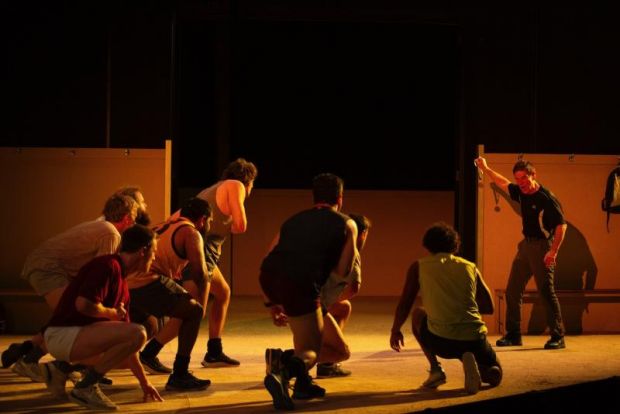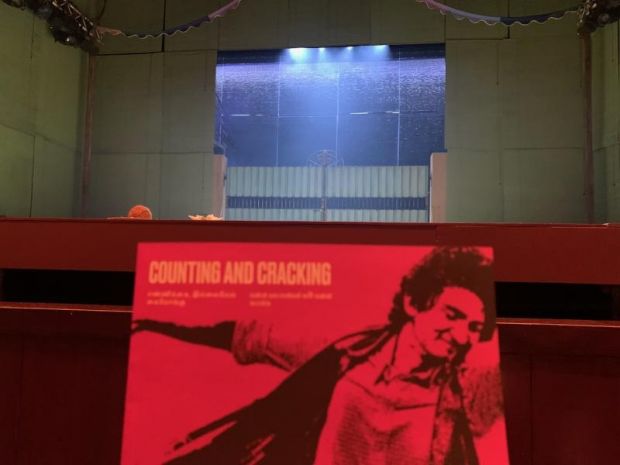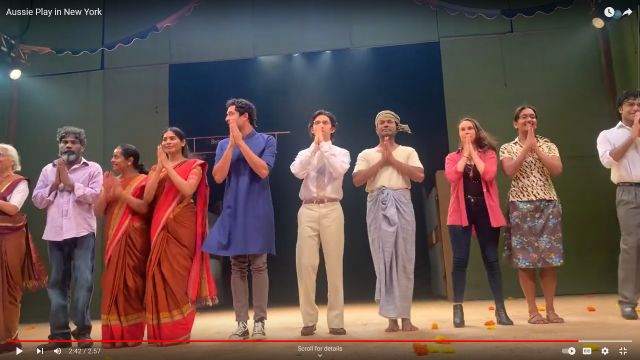Cracking The Big Apple
The epic Australian play Counting and Cracking has opened in New York for a three week season sponsored by the Public Theatre after completing seasons in Sydney, Adelaide, Melbourne and Edinburgh. See below for Stage Whispers TV's exclusive coverage of their first preview. The ensemble of 19 is bucking the trend towards smaller casts. David Spicer reports.
The hottest export play from Australia in recent years – The Picture of Dorian Gray - had a cast of one! In the West End, Sarah Snook played all the characters in the stage adaptation of Oscar Wilde’s Victorian novella and took home the Olivier Award for Best Actress for good measure.
The formula was repeated at the Sydney Theatre Company with its major production of Dracula – also with one actress playing all the roles – some pre-recorded.
This trend has sparked a debate about whether opportunities are declining for professional actors.
On the podcast Stages with Peter Eyers, Damien Ryan from the Sport for Jove theatre company noted that, “There are less actors on our stages. The big financial imperative is dangerous in theatre.
“When I was with Bell Shakespeare we would have 15 people in an ensemble. Nowadays there are 8 or 9 in any major productions of Shakespeare in the country.
“What Kip has been doing at the Sydney Theatre Company with one actor on stage is more common.”
 Image: 37 - Photographer - Pia Johnson.
Image: 37 - Photographer - Pia Johnson.
The largest cast production this year for Melbourne Theatre Company and Queensland Theatre was for 37, a play about racism in Aussie Rules, with ten actors.
Queensland Theatre’s Associate Artistic Director Fiona MacDonald said it was only possible as a co-production between the two companies. She says audiences loved the large ensemble. “There is something beautiful in seeing a large number of people on stage doing incredible things. There was joy and power in the movement sequences.”
In commercial theatre, Death of a Salesman from GWB Entertainment and Andrew Henry had a cast of 14.
Big can be big box office. Counting and Cracking, a sprawling multi-generation saga traversing Sri Lanka and Australia was a hit at the Sydney Festival in 2019 and has since played in Adelaide, Melbourne a return season in Sydney and Edinburgh.
The play has opened in New York for a three week season sponsored by New York University and The Public Theatre.

Ahead of the return season in Sydney i discussed the issue of cast sizes with Eamon.
Do you agree that there are fewer professional actors on the stage these days?
I expect there’s been a decrease. The only pressure we face on cast sizes is financial. The pressures on theatre companies are immense: decades of underfunding, costs rising far faster than the rest of the economy, massive cost-of-living pressures on actors, changing audience buying patterns – all make it harder to gather big casts.
But we’ve made it a central plank of our producing model to have 60 or more actors in every season and to do at least two big cast plays every year. And our big cast plays are getting bigger, not smaller.
Do you think that the move to doing more plays with a small ensemble and using AV to make up the rest of the cast is here to stay or a fad?
Small cast plays are an inherent feature of modern theatre, for artistic, cultural and financial reasons. I wouldn’t say that AV is being used to replace actors. Kip’s cine-theatre shows are an artistic project rather than a cost-saving measure.
If anything, they possibly end up costing more than a big cast show because the tech is expensive and you still need a bunch of crew. So yes, fewer roles for actors, but more roles for other creatives and crew.
How did Counting and Cracking come about?
Counting and Cracking is a massive show. It sits entirely outside our normal producing capacity. Every time we revive it, it’s always a partnership with at least two or three other major organisations and a whole bunch of supporters and donors.
Why was it imperative that this production have a large cast?
The playwright Shakthi and I worked on the show together for over six years before it finally saw an audience. In that time the cast size got bigger, not smaller. We kept adding characters. Which is unusual, to say the least.
The size of the project was led entirely by the nature of the work itself: multiple timeframes, multiple generations, many different communities. The very meaning of the work is the idea that many people can and must work together to move us all past the worst, to avoid one group turning on another.
What have the rewards been for this large cast?
This cast is a community all of its own. They are a magnificent group of humans – full of generosity and care. They take care of each other. It’s not accidental that the personality of the play matches the personality of the cast. But they are all in service to the work, and the work requires an ethos of openness, collaboration, joy, play, care, seriousness…
What is unique about this production and its evolution?
It tells a new kind of Australian story. It tells a new kind of Sri Lankan story, one that perhaps couldn’t really be told in Sri Lanka. It uses multiple languages in a very specific theatrical and dramaturgical way. It invents a whole lot of forms of theatricality and collaboration, drawing both on Belvoir’s history of theatrical playfulness and on South Asian practicality and ingenuity. It mixes Brechtian political theatre techniques with South Asian epic storytelling: love and politics are given equal weight.
The show evolved like nothing has before because no one had done anything like it before. We had to work out how to do it. From the dramaturgy to the casting, to the producing, we needed to borrow and mix and invent processes the whole way along.
The production is going to New York with its full Australian cast?
Yes, it’s the same cast for all three seasons this year – Melbourne, Sydney and New York. But when we say “Australian” cast, it’s worth noting that some of the cast are from Sri Lanka, India, New Zealand, France and Malaysia.
How exciting and daunting is that?
It’s very exciting and not very daunting. I say not daunting because this team – the cast, the creatives, and the crew – are a whole little world. We take our values everywhere we go, all the time, so we can’t really fail.
Could you ever stage Counting and Cracking with a few actors and video projection of the rest of the characters?
No.
Images of Counting and Cracking in New York by David Spicer.
Subscribe to our E-Newsletter, buy our latest print edition or find a Performing Arts book at Book Nook.

